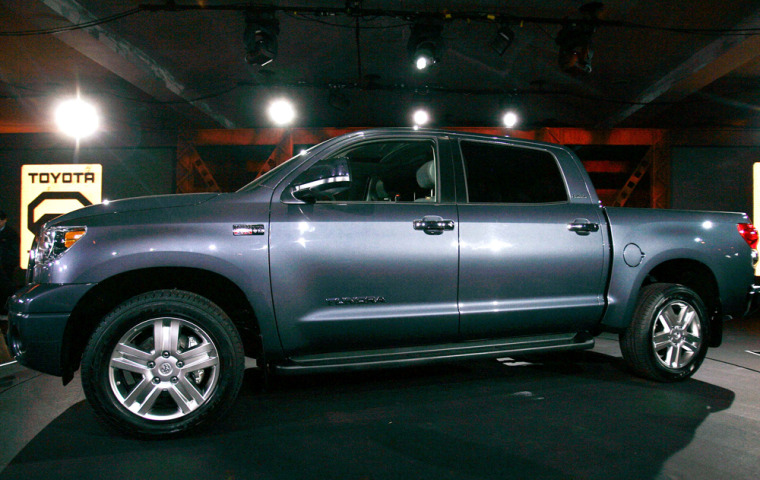Of the hundreds of new vehicles on display at this year’s North American International Auto Show in Detroit, Toyota’s hulking 2007 Tundra CrewMax looks out of place.
Larger in every dimension than the truck it replaces and available in 31 model configurations, the new Tundra half-ton pickup is set to challenge the big trucks produced by rivals General Motors and Ford. But it flies in the face of the theme of this year’s auto show.
Instead of big sport utility vehicles and trucks, most automakers at this year’s Detroit show are emphasizing basic midsize passenger cars and “crossover” vehicles — scaled-down versions of SUVs built on car platforms, offering drivers a smoother ride and improved gas mileage.
“GM and Ford are the business case study for not relying on just one vehicle — they have been so dependent on the profitability of their sport utility vehicles and pickup trucks in years gone by, and so now they have to come out with new money-making cars,” said Rebecca Lindland, industry analyst at consulting company Global Insight.
A prime example was the Chevrolet Volt concept car unveiled by General Motors at the show. The vehicle, which is not expected to be available before 2010, is designed to run on little or no gasoline, can be recharged from a conventional wall socket in a home and will run on battery power alone for up to 40 miles.
Also on show: DaimlerChrysler’s 2008 Smart Fortwo, a small two-seater car aiming to benefit from Americans’ growing preference for small cars, which would build on the success of the Mini. The tiny car is expected to arrive in the U.S. in January 2008.
There’s a reason for the attitude change: The price of gasoline soared above $3 a gallon last summer, driving consumers toward smaller, more fuel-efficient cars. The price of gas has since dropped back toward $2, but consumers are well aware it can soar again, and so consumers’ newfound desire for fuel-efficient vehicles is unlikely to prove fleeting.
Indeed, new figures show fuel efficiency — alongside quality and safety — is a top criterion that automotive executives think is most important to car consumers when they buy a new vehicle.
According to a recent survey by advisory firm KPMG, 89 percent of automotive executives questioned said they think fuel economy is extremely important or important to consumers who are looking to buy a new vehicle, compared with 84 percent last year. The survey was produced by polling 150 senior executives at automakers and suppliers worldwide.
The survey also found that 83 percent of industry executives think gas-electric hybrid vehicles will see their market share increase over the next five years, while 64 percent expected cars to see gains in market share. Ninety-five percent of North American executives said they were likely to see a rise in hybrid sales over the next five years, while 67 percent of North American executives predicted crossover sales will grow.
Only 33 percent of executives in North America said they expect to see larger vehicles, such as minivans, gain market share. Just 28 percent said SUVs would gain market share.
“Gasoline prices have shifted the model mix in executives’ minds, and future winners in the global automotive marketplace will have to find ways to combine ingenious cost-efficiencies with startling design creativity,” said Daron Gifford, head of automotive industry research at KPMG.
Even as gas prices have declined, executives see strong consumer interest in fuel efficiency.
“Gasoline prices [have come down] to these levels, and sales of smaller cars and crossovers are still steady, so I don't think this trend will change,” said Koichi Kondo, head of Honda’s North American operations, said the company, which claims to sell the most fuel-efficient fleet in the United States.
But there are some skeptics.
David Champion, senior director of the automotive test center at Consumer Reports, says research at his organization suggests that while $3 a gallon gasoline got car-buyers attention, it will take prices $4 or even $4.50 a gallon to force real change in buying habits. Pump prices falling back toward $2 could lure consumers back to buying large SUVs, he said.
Higher gas prices certainly put a damper on SUV sales last year. Sales of U.S. light trucks fell 6.7 percent in 2006 according to data from Automotive News, with sales of pickup trucks down 10.2 percent and SUVs off 9.8 percent. At the same time crossover vehicles — which the industry counts as trucks — saw a sales increase of 4.1 percent.
This sales decline has hurt the Big Three of GM, Ford and Chrylser, which have remained heavily dependent on the highly profitable SUV sales strategy of the 1990s. Partly as a result, they have been losing share to Japanese brands which have focused more on sedans and other fuel-friendly vehicles, such as hybrids.
